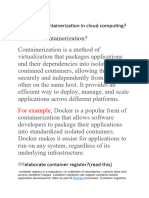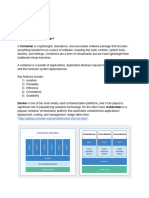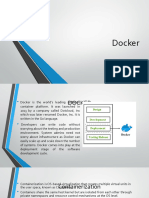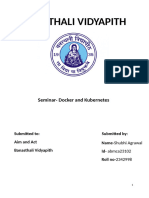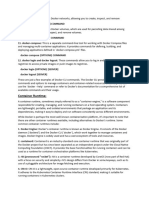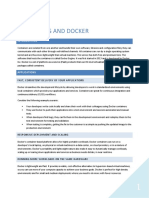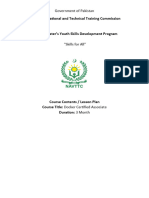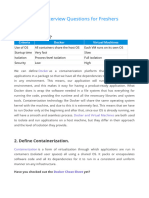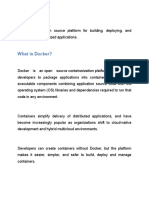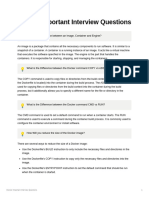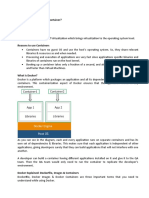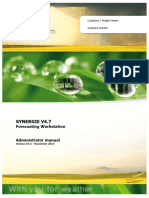0 ratings0% found this document useful (0 votes)
27 viewsDocker
Docker
Uploaded by
Tejas SawantDocker is a containerization platform that packages applications and dependencies into containers to ensure applications run seamlessly across environments. It was created in 2013 to simplify application deployment and management using containers. Docker uses a client-server architecture with clients communicating with the Docker daemon via APIs to build images from Dockerfiles, run containers from images, and store images in public/private registries for collaboration. Containers are lightweight and portable, allowing applications to be deployed flexibly on various platforms while maintaining performance.
Copyright:
© All Rights Reserved
Available Formats
Download as RTF, PDF, TXT or read online from Scribd
Docker
Docker
Uploaded by
Tejas Sawant0 ratings0% found this document useful (0 votes)
27 views9 pagesDocker is a containerization platform that packages applications and dependencies into containers to ensure applications run seamlessly across environments. It was created in 2013 to simplify application deployment and management using containers. Docker uses a client-server architecture with clients communicating with the Docker daemon via APIs to build images from Dockerfiles, run containers from images, and store images in public/private registries for collaboration. Containers are lightweight and portable, allowing applications to be deployed flexibly on various platforms while maintaining performance.
Copyright
© © All Rights Reserved
Available Formats
RTF, PDF, TXT or read online from Scribd
Share this document
Did you find this document useful?
Is this content inappropriate?
Docker is a containerization platform that packages applications and dependencies into containers to ensure applications run seamlessly across environments. It was created in 2013 to simplify application deployment and management using containers. Docker uses a client-server architecture with clients communicating with the Docker daemon via APIs to build images from Dockerfiles, run containers from images, and store images in public/private registries for collaboration. Containers are lightweight and portable, allowing applications to be deployed flexibly on various platforms while maintaining performance.
Copyright:
© All Rights Reserved
Available Formats
Download as RTF, PDF, TXT or read online from Scribd
Download as rtf, pdf, or txt
0 ratings0% found this document useful (0 votes)
27 views9 pagesDocker
Docker
Uploaded by
Tejas SawantDocker is a containerization platform that packages applications and dependencies into containers to ensure applications run seamlessly across environments. It was created in 2013 to simplify application deployment and management using containers. Docker uses a client-server architecture with clients communicating with the Docker daemon via APIs to build images from Dockerfiles, run containers from images, and store images in public/private registries for collaboration. Containers are lightweight and portable, allowing applications to be deployed flexibly on various platforms while maintaining performance.
Copyright:
© All Rights Reserved
Available Formats
Download as RTF, PDF, TXT or read online from Scribd
Download as rtf, pdf, or txt
You are on page 1of 9
1) Docker is the containerization platform that
is used to package your application and all its
dependencies together in the form of containers
to make sure that your application works
seamlessly in any environment which can be
developed or tested or in production.
2) Docker is a tool designed to make it easier to
create, deploy, and run applications by using
containers.
3) Docker is the world’s leading software
container platform. It was launched in 2013 by
a company called Dotcloud, Inc which was later
renamed Docker, Inc. It is written in the Go
language.
Docker Architecture
Docker architecture consists of Docker client,
Docker Daemon running on Docker Host, and
Docker Hub repository. Docker has client-
server architecture in which the client
communicates with the Docker Daemon
running on the Docker Host using a
combination of REST APIs, Socket IO, and
TCP.
Components of Docker
1. Docker Clients and Servers– Docker
has a client-server architecture. The
Docker Daemon/Server consists of all
containers. The Docker Daemon/Server
receives the request from the Docker
client through CLI or REST APIs and thus
processes the request accordingly. Docker
client and Daemon can be present on the
same host or different host.
1) Docker Images– Docker images are
used to build docker containers by using
a read-only template.
2) Docker File– Dockerfile is a text
file that contains a series of instructions
on how to build your Docker image.
3) Docker Registries– Docker
Registry is a storage component for
Docker images. We can store the images
in either public/private repositories so
that multiple users can collaborate in
building the application.
4) Docker Containers– Docker
Containers are runtime instances of
Docker images. Containers contain the
whole kit required for an application, so
the application can be run in an isolated
way.
Advantages of Docker –
1. Speed – The speed of Docker containers
compared to a virtual machine is very fast.
The time required to build a container is
very fast because they are tiny and
lightweight.
2. Portability – The applications that are
built inside docker containers are
extremely portable. These portable
applications can easily be moved
anywhere as a single element and their
performance also remains the same.
3. Scalability – Docker has the ability that
it can be deployed on several physical
servers, data servers, and cloud platforms.
It can also be run on every Linux
machine. Containers can easily be moved
from a cloud environment to a local host
and from there back to the cloud again at a
fast pace.
4 Density – Docker uses the resources
that are available more efficiently
because it does not use a hypervisor.
This is the reason that more containers
can be run on a single host as compared
to virtual machines. Docker Containers
have higher performance because of
their high density and no overhead
wastage of resources.
You might also like
- What Is Docker?: Drawback of VirtualizationDocument2 pagesWhat Is Docker?: Drawback of VirtualizationDeepak PNo ratings yet
- Chapter 5 CCDDocument17 pagesChapter 5 CCDTejas SawantNo ratings yet
- 01.Container and DockerDocument18 pages01.Container and DockerSaurav Paliwal 12ANo ratings yet
- DockerDocument2 pagesDockervaibhavwani008No ratings yet
- Docker Fundamentals Day 1 1702198839Document7 pagesDocker Fundamentals Day 1 1702198839priyaNo ratings yet
- Container& Docker1Document27 pagesContainer& Docker1YuvikaNo ratings yet
- Docker and KubernetesDocument29 pagesDocker and Kubernetessarakore2108No ratings yet
- MACHINE LEARNINGDocument5 pagesMACHINE LEARNINGDivya Elizabeth MathewNo ratings yet
- DevOps Chapter-5Document28 pagesDevOps Chapter-5vortNo ratings yet
- Docker and KubernetesDocument23 pagesDocker and KubernetesShubhi AgrawalNo ratings yet
- Install Docker and Deploy Container in DockerDocument8 pagesInstall Docker and Deploy Container in DockerAtharva JadhavNo ratings yet
- CC Unit VIDocument22 pagesCC Unit VIhellomaheshNo ratings yet
- An Introduction To Docker: Digital Learning PortalDocument18 pagesAn Introduction To Docker: Digital Learning PortalAnonymous NeRBrZyAUbNo ratings yet
- Learn Docker in Depth 1700611666Document27 pagesLearn Docker in Depth 1700611666cumar2014No ratings yet
- Docker Basics CorrectedDocument2 pagesDocker Basics CorrectedsabankorogluNo ratings yet
- DockerDocument50 pagesDockerRabeb MessadiNo ratings yet
- Docker GuideDocument62 pagesDocker Guidevishal.pandeyNo ratings yet
- Docker NotesDocument8 pagesDocker NotesHEMALAKSHMI DNo ratings yet
- Docker Part2Document6 pagesDocker Part2anbuchennai82No ratings yet
- BT L1 L2 HadoopDocument11 pagesBT L1 L2 HadoopTUaN dAo qUOcNo ratings yet
- Docker Interview Questions Answers 1641488372Document21 pagesDocker Interview Questions Answers 1641488372Abhishek Prasoon100% (1)
- Containers and Docker: Fast, Consistent Delivery of Your ApplicationsDocument5 pagesContainers and Docker: Fast, Consistent Delivery of Your ApplicationsArafat ChowdhuryNo ratings yet
- Docker Notes-1Document17 pagesDocker Notes-1ediga madhuNo ratings yet
- Lecture 13Document20 pagesLecture 13Rashid suraniNo ratings yet
- Es Unit 5Document14 pagesEs Unit 5sathvika rathkantiNo ratings yet
- DockersDocument18 pagesDockershaider rizviNo ratings yet
- Top 50+ Docker Interview Questions & AnswersDocument26 pagesTop 50+ Docker Interview Questions & Answersrakeshsharma0inaNo ratings yet
- Docker Unit 1 & 3 FinalDocument52 pagesDocker Unit 1 & 3 FinalTamannaNo ratings yet
- Unit 6Document28 pagesUnit 6Aman SinghNo ratings yet
- Docker and KubernetesDocument12 pagesDocker and KubernetesSofiya KhanNo ratings yet
- Intro To DockerDocument8 pagesIntro To DockergabrielNo ratings yet
- Docker Certified AssociateDocument23 pagesDocker Certified AssociateanonzeviraNo ratings yet
- Dockar InterviewDocument28 pagesDockar InterviewviswaNo ratings yet
- DockerDocument17 pagesDockererashappyNo ratings yet
- DockerDocument12 pagesDockerkanmaniprsnlNo ratings yet
- CND - Docker - Unit - IV-IDocument28 pagesCND - Docker - Unit - IV-IDhanush reddyNo ratings yet
- DockerwithKubernetes19112018 PDFDocument173 pagesDockerwithKubernetes19112018 PDFSurEnder VeRmaNo ratings yet
- HCIP-Cloud Computing-Container V1.0 Training Material PDFDocument642 pagesHCIP-Cloud Computing-Container V1.0 Training Material PDFAFRI YANTONo ratings yet
- Docker FundamentalsDocument10 pagesDocker FundamentalsNesrin BrahimNo ratings yet
- 09 ContainersDocument43 pages09 ContainerssanicbearNo ratings yet
- CONTAINERIZATIONDocument28 pagesCONTAINERIZATIONGargiNo ratings yet
- L7 Docker 27032023 024836pmDocument9 pagesL7 Docker 27032023 024836pmHuma ZaheerNo ratings yet
- DockerDocument21 pagesDockerzarli HtunNo ratings yet
- DockerDocument4 pagesDockeribeanxinhNo ratings yet
- Docker ContainersDocument25 pagesDocker ContainersRima AlayaNo ratings yet
- Docker (Spark Team)Document16 pagesDocker (Spark Team)yahiaprintingNo ratings yet
- Docker Interview Qustions and AnswersDocument3 pagesDocker Interview Qustions and AnswershemanthNo ratings yet
- Docker Interview - FAQs & AnswersDocument4 pagesDocker Interview - FAQs & AnswersvikrammoolchandaniNo ratings yet
- Docker: The Complete Guide to the Most Widely Used Virtualization Technology. Create Containers and Deploy them to Production Safely and Securely.: Docker & Kubernetes, #1From EverandDocker: The Complete Guide to the Most Widely Used Virtualization Technology. Create Containers and Deploy them to Production Safely and Securely.: Docker & Kubernetes, #1No ratings yet
- Introduction Docker and Analysis of Its PerformanceDocument13 pagesIntroduction Docker and Analysis of Its Performancekhedlekar shrutiNo ratings yet
- docker-interviw-questionsDocument49 pagesdocker-interviw-questionsAhmed MahjoubNo ratings yet
- Docker NotesDocument17 pagesDocker Notesbharatvarshney2025No ratings yet
- WP IntrotoContainerSecurity 08.19.2016Document13 pagesWP IntrotoContainerSecurity 08.19.2016Holub BilalNo ratings yet
- Docker Important Interview QuestionsDocument6 pagesDocker Important Interview Questionsmanishal45667No ratings yet
- What Is Docker & Docker Container?Document4 pagesWhat Is Docker & Docker Container?magillaniNo ratings yet
- Docker Interview QuestionsDocument6 pagesDocker Interview QuestionsSanjay Gupta100% (1)
- Unit 3 Final 1Document153 pagesUnit 3 Final 1dhanrajpandya26No ratings yet
- Docker Intro v1.0Document32 pagesDocker Intro v1.0Ramona DinescuNo ratings yet
- Docker Intro v1.0Document32 pagesDocker Intro v1.0Ramona DinescuNo ratings yet
- Docker For Multi-Containers Web ApplicationDocument4 pagesDocker For Multi-Containers Web Applicationbryanestudos27No ratings yet
- CN Coding NinjasDocument127 pagesCN Coding Ninjasdetedi9400No ratings yet
- Socket Programming SlidesDocument20 pagesSocket Programming SlidesPoonam YadavNo ratings yet
- Chapter 17 Distributed Software Engineering 1 20/11/2014Document66 pagesChapter 17 Distributed Software Engineering 1 20/11/2014Abdul MateenNo ratings yet
- Airline Reservation SystemDocument13 pagesAirline Reservation SystemInpreet KaurNo ratings yet
- PACiS Subsation AutomationDocument12 pagesPACiS Subsation Automationanon_205398010No ratings yet
- Network SoftwareDocument32 pagesNetwork SoftwareUjjwalNo ratings yet
- CISA Exam Prep Domain 5 - 2019Document89 pagesCISA Exam Prep Domain 5 - 2019nhoporegNo ratings yet
- Peer To Peer Networks Common P2P Examples: - Napster - Morpheus - Gnutella - Freenet - Bittorrent - SkypeDocument6 pagesPeer To Peer Networks Common P2P Examples: - Napster - Morpheus - Gnutella - Freenet - Bittorrent - SkypemetallicamegadNo ratings yet
- Tribon Data Base SuperserverDocument17 pagesTribon Data Base SuperserverRahul PhadakeNo ratings yet
- Architectural Patterns: Chapter 9: Architecting and Designing Software 1/26Document40 pagesArchitectural Patterns: Chapter 9: Architecting and Designing Software 1/26yasser alaliNo ratings yet
- Synergie 4.7 - Administrator ManualDocument58 pagesSynergie 4.7 - Administrator ManualDjosa LuzNo ratings yet
- List of Questions: Brightway ComputersDocument70 pagesList of Questions: Brightway Computersdinesh9866119219No ratings yet
- MC9251 Middleware Technologies Unit-1Document26 pagesMC9251 Middleware Technologies Unit-1mknages_mca8573100% (1)
- Building Secure and Reliable Network ApplicationsDocument4 pagesBuilding Secure and Reliable Network ApplicationsTamiru DerejeNo ratings yet
- Pedal-to-the-Metal Analytics With SAS® Studio, SAS® Visual Analytics, SAS® Visual Statistics, and SAS® Contextual AnalysisDocument20 pagesPedal-to-the-Metal Analytics With SAS® Studio, SAS® Visual Analytics, SAS® Visual Statistics, and SAS® Contextual AnalysisFlorin CorneaNo ratings yet
- Web Technology and Dbmss TransparenciesDocument76 pagesWeb Technology and Dbmss TransparenciesInes Della AstriaNo ratings yet
- DCOM Technical OverviewDocument33 pagesDCOM Technical OverviewravitejasrinuNo ratings yet
- Module 15: Application Layer: Introduction To Networks v7.0 (ITN)Document35 pagesModule 15: Application Layer: Introduction To Networks v7.0 (ITN)thanh vienNo ratings yet
- Peer To Peer NetworkDocument60 pagesPeer To Peer Networksw4t.catNo ratings yet
- Distributed Multimedia SystemsDocument38 pagesDistributed Multimedia SystemsMr.T.Vijayakumar Assistant ProfessorNo ratings yet
- Bill Hughes: 29 Jacobs Road Randolph, MA 02368 617-401-7797 Bill - Hughes@post - Harvard.eduDocument4 pagesBill Hughes: 29 Jacobs Road Randolph, MA 02368 617-401-7797 Bill - Hughes@post - Harvard.eduapi-6675012No ratings yet
- Database Assignment#01Document9 pagesDatabase Assignment#01hiramujeeb15No ratings yet
- MIS at BOSCHDocument57 pagesMIS at BOSCHJ Narendhar 2027909No ratings yet
- Ooad Unit-VDocument25 pagesOoad Unit-VVadlamudi DhyanamalikaNo ratings yet
- Week 4 Application Layer Without VideosDocument45 pagesWeek 4 Application Layer Without VideosIskandar HazryllNo ratings yet
- Client Server ChattingDocument66 pagesClient Server ChattingsaritakatariaNo ratings yet
- CN Tutorial PYQDocument5 pagesCN Tutorial PYQchester cNo ratings yet
- Iot-Based Enterprise Resource Planning: Challenges, Open Issues, Applications, Architecture, and Future Research DirectionsDocument28 pagesIot-Based Enterprise Resource Planning: Challenges, Open Issues, Applications, Architecture, and Future Research DirectionsProyectoTxNo ratings yet
- Web Application Development Lesson 1Document19 pagesWeb Application Development Lesson 1Iñakie PulusanNo ratings yet
- Network and System Administration Chapter 3Document10 pagesNetwork and System Administration Chapter 3Eyob HabteNo ratings yet

